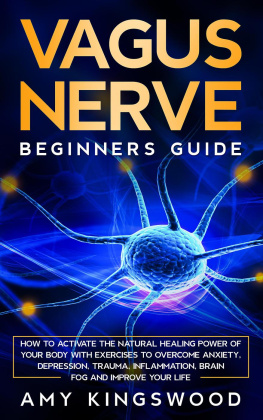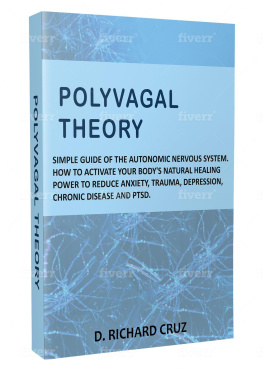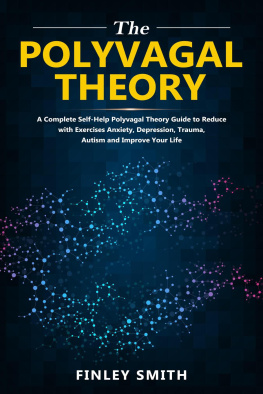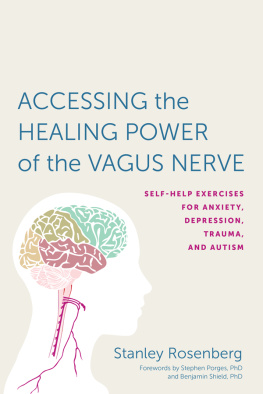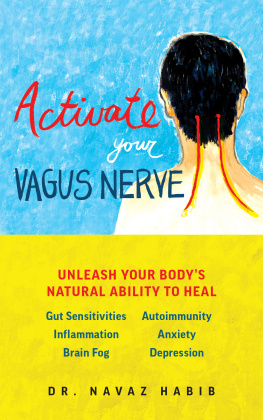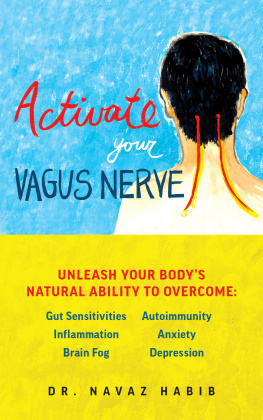
Copyright 2017 by Stanley Rosenberg. All rights reserved. No portion of this book, except for brief review, may be reproduced, stored in a retrieval system, or transmitted in any form or by any meanselectronic, mechanical, photocopying, recording, or otherwisewithout the written permission of the publisher. For information contact North Atlantic Books.
Published by
North Atlantic Books
Berkeley, California
Cover art by Jasmine Hromjak. All other illustrations by Sohan Mie Poulsen; Stanley Rosenberg 2017. Photographs by Tau Bjorn Rosenberg
Cover design by Nicole Hayward
Book design by Suzanne Albertson
Printed in Canada
Accessing the Healing Power of the Vagus Nerve: Self-Help Exercises for Anxiety, Depression, Trauma, and Autism is sponsored and published by the Society for the Study of Native Arts and Sciences (dba North Atlantic Books), an educational nonprofit based in Berkeley, California, that collaborates with partners to develop cross-cultural perspectives, nurture holistic views of art, science, the humanities, and healing, and seed personal and global transformation by publishing work on the relationship of body, spirit, and nature.
North Atlantic Books publications are available through most bookstores. For further information, visit our website at www.northatlanticbooks.com or call 800-733-3000.
MEDICAL DISCLAIMER: The following information is intended for general information purposes only. Individuals should always see their health care provider before administering any suggestions made in this book. Any application of the material set forth in the following pages is at the readers discretion and is his or her sole responsibility. The author takes full responsibility for representing and interpreting the ideas related to the Polyvagal Theory. The authors interpretations and representations of the Polyvagal Theory may vary in intent and accuracy from the writings and presentations by Dr. Stephen W. Porges.
Library of Congress Cataloging-in-Publication Data
Rosenberg, Stanley, 1940
Accessing the healing power of the vagus nerve : self-help exercises for anxiety, depression, trauma, and autism / Stanley Rosenberg.
pages cm
ISBN 978-1-62317-024-0 (Trade paperback) ISBN 978-1-62317-025-7 (Ebook)1. Depression, MentalAlternative treatment. 2. AnxietyAlternative treatment. 3. AutismAlternative treatment. 4. Vagus nerve. 5. Self-care, Health. I. Title.RC537.R63844 2016616.8527dc232015028780
North Atlantic Books is committed to the protection of our environment. We partner with FSC-certified printers using soy-based inks and print on recycled paper whenever possible.
To Linda Thorborg
Foreword
I met Stanley in June 2002, when I spoke at the United States Association for Body Psychotherapy Conference in Baltimore. The evening before my talk I received a message from Jim Oschman asking if he and Stanley could attend. Jim explained that I would enjoy meeting Stanley and learning about his work. After my talk, Stanley explained his desire to identify objective measures, such as heart rate variability, that could be used to conduct research to validate the clinical work he was doing.
I was curious and wanted to learn more about his work, his approach, and why he was interested in measurements of vagal function. I mentioned to him that I had spondylolisthesis, a condition in which a vertebra slides forward over the bone below it. He casually responded, I can fix it. I asked him how long he thought it would take. He said about ten to fifteen seconds! At this point I was trying to figure out what he could do in ten to fifteen seconds. I had assumed, based on his training in Rolfing and craniosacral techniques, that his treatment would require several sessions. Given my history with an orthopedic specialist, I was curious if a somatic therapy could be effective. The suggestion that it could be rehabilitated in a few seconds was outside my worldview.
My diagnosis was based on a slippage in the lower spine at the junction of lumbar and sacral vertebrae. The slippage caused back pain and possibly a progressive deterioration that would lead to surgery. I was diagnosed by an orthopedic surgeon, who imposed on me a fear of surgery to motivate progress in physical therapy. Following my graduation from physical therapy, I went to a sports medicine physician who prescribed a back brace to limit mobility. From this portfolio of health care professionals, I received contradictory instructions; the physicians encouraged me to immobilize the lower back, while the physical therapists encouraged me to move and work on flexibility. By the time I met Stanley, it was not clear to me how to treat my condition to minimize symptoms and avoid surgery.
When Stanley generously offered to fix it, I welcomed the opportunity. Stanley instructed me to go on my hands and knees, and to relax and keep my spine relatively level. Then, with the fingers from both hands going in opposing directions, he moved the tissue over the vertebrae that had slipped. As he did this, the vertebrae immediately and effortlessly slipped into position. For fifteen years I have used a modification of his procedure to remain pain free.
I understood immediately what he was doing. The physical manipulation, which gently moved the upper levels of tissue, signaled the body to relax. The relaxation was sufficient to reorganize the neural muscular regulation that supported the spine, allowing the vertebra to gently fall into place. Thus Stanley was transmitting signals of safety to the neuromuscular system that enabled the system to immediately shift from a defensive state of contraction, in which it attempted to protect the vulnerability of the lower spine, to a state of safety in which a gentle touch would functionally allow the system to find its natural position.
Stanleys method confirmed that a metaphor of safety is manifest throughout the body and not merely in the social engagement system via the muscles of the face and head, or in the viscera via ventral vagal pathways. In all aspects of the human anatomy, safety is expressed by the down regulation and the constraint of defense. When safety occurs, the structures can retune themselves to support health, growth, and restoration. Functionally, Stanleys work is based on his implicit understanding that when the nervous system is manifest in a state of safety there is a welcoming to touch, which can be used to align bodily structures and optimize autonomic function.
Our first meeting captured Stanleys essence and brilliance. It captured his passionate desire to alleviate pain and suffering. It captured his compassionate approach that supports states of safety through gentle co-regulation. And it captured his intuitive understanding of the integrated systems of the body.
Stanley and I have now been good friends for fifteen years. In multiple visits we have discussed how his manipulations shift autonomic state to promote health, growth, and restoration. As this book conveys, he has brilliantly integrated features of the Polyvagal Theory with features from craniosacral and other somatic therapies. To do this, he artfully extracted the primary principle of the Polyvagal Theory: the structures of the body become welcoming to touch and manipulation when in a state of safety.
According to the Polyvagal Theory, the body, including the neural regulation of skeletal muscle, functions differently when in a state of safety. In the state of safety, ventral vagal pathways coordinate the autonomic nervous system. In this state, the defensive features of the autonomic nervous system are constrained, and the body is welcoming not only to the social engagement behaviors of prosodic vocalizations and facial expressions, but to touch. Underlying Stanleys clinical successes is his ability to connect and co-regulate the client through interactions between the clients social engagement systems, and to convey cues of trust and concern that trigger the beneficial attributes of the ventral vagal circuit in promoting a state of safety through the entire body.
Next page

